THE METAMORPHOSIS OF A BROOKLYN BLOCK
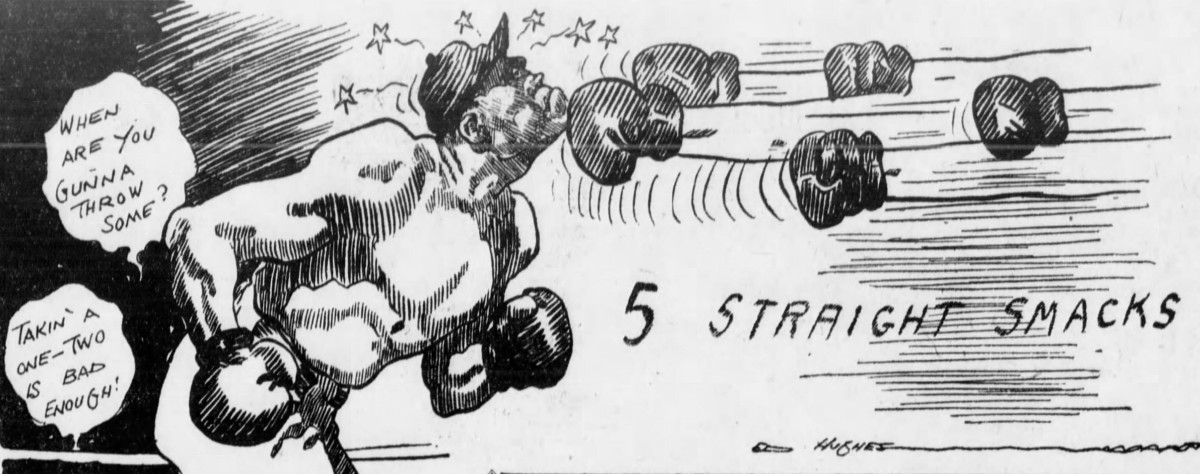
After showcasing some serious open-air ball playing, Saratoga Field was about to go indoors. There it would bear witness to a number of more diverse activities – dancing, fighting, and dreaming.
But not necessarily in that order.
By 1912, the owners of the block that Saratoga Field had utilized would realize the cash potential of developing the grounds for its marketing to commercial investors. Accordingly, they divided the land up into lots and sold it all off to real estate developers.
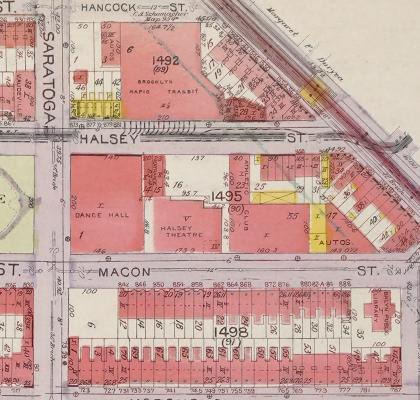
Shortly afterwards, three new entertainment businesses would appear on the block – the Broadway Boxing Arena, the Halsey Theatre, and the Arcadia Dance Hall, all just across the street from the Brooklyn Rapid Transit (BRT) carbarn and Saratoga Square.
THE BROADWAY ARENA
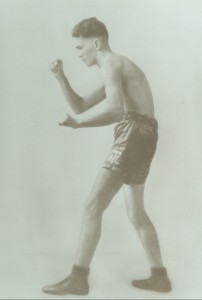
The Broadway Arena (also known as the Broadway Sporting Club and the Broadway Exhibition Association Building) sat next to the Halsey Theatre (an alley in between), operating for close to 40 years. It was built around 1912 and had a capacity of 4,500 people. It would become Brooklyn’s top fight arena in the 1930s and 1940s, exhibiting the boxing skills of some of the country’s more well-known fighters, such men as Al Tiernan, Arturo Godoy (who fought Joe Louis in 1940), and Pete Sanstol.
By 1951 the Broadway Arena was closed, the victim of competition from the television set. Its last boxing match was held on 29 November 1951.
THE HALSEY THEATRE
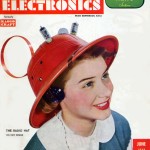
The Halsey Theater, a 2,100-seat theater, which originally presented both vaudeville and silent movies, was built in 1912, and was located on Halsey Street between Saratoga Avenue and Broadway. Here, Jackie Gleason got his start in standup at amateur nights, where he won first place in an amateur contest and, as a result, got his first job at 13 years of age.
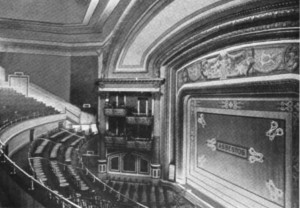
By 1943, The Halsey Theatre, too, had fallen on hard times and closed. It was rented out, though, in the late ’40s to a company called The Merri-Lei Corporation, which made cardboard leis and party favors, and around the time of its occupancy in the building, made the (now) iconic “Man From Mars Radio Hat.”
A simple party favor company, its owner, Victor Hoeflich, was dubbed “Brooklyn’s Impressario of Discord” by Popular Science Magazine. A master self-promoter, he developed his brainchild hat in 1949 and produced it for a few years. In spite of enormous advertising for the device, the hat was not produced beyond the early ’50s.
Around 1967, The Halsey Theater was finally put to rest, being torn down in preparation for other development.
THE ARCADIA DANCE HALL
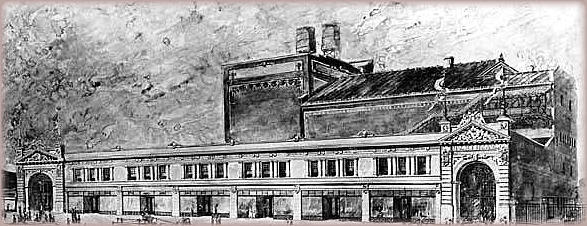
The Arcadia Dance Hall fronted Saratoga Avenue between Macon and Halsey Streets and was next to the Halsey Theatre. The ballroom was a 1-story, 150×200 foot fireproof structure, and had a dancing space of 89×100 feet and a promenade 25 feet wide.
It was “splendidly lighted with a seating capacity of 4,500, and it (was) everything that a dance hall should be in every way,” noted feminist author Djuna Barnes, in her first piece of “newspaper fiction” in the Brooklyn Eagle in 1913.

By the 1910s, more than 500 public dance halls were open each evening in the Greater New York area. And their popularity was eclipsing the movie theatres and vaudeville halls – which both pleased and frightened “better society,” which saw the latest styles of dancing as simple interludes to immorality.
The introduction of such dance halls were seen by some as the slippery slope into the evils of immorality. Others, taking the opposite tack, saw the attraction of youth to dancing as an opportunity to educate and improve upon society’s morals.
Such groups as the “Committee on Amusement and Vacation Resources for Working Girls,” were instrumental in passing the “decent dance hall legislation,” and has “waged unceasing warfare on the turkey trot and other sensational dances.”
The opening of the Arcadia, however, had the committee members proclaiming their “jubilance,” noting that there will be “no turkey trotting, bunny-hugging, or other improper dances.”
The admission fee at the Acadia was 10 and 15 cents.
In Djuna Barnes’s article, one of her characters, Delia O’Conner, claimed that the Arcadia had the movie halls, “beaten to a thirty-nine cent bargain sale on a rainy Monday.”
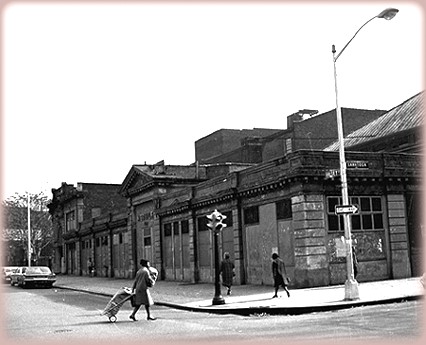
“And so the evening wore on,” she continued. “Everyone had a glorious time. The Arcadia was light and cool, the music was good, and best of all, the authorities were not too critical. One might even tango a little in a tame sort of way. The whole place was pervaded with an air of refinement and good behavior (and the men who are running it intend to keep it so).
“At last midnight came, the lights were lowered, and the dancers departed.”
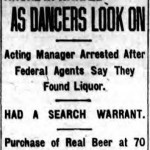
While on the weekends, the hall was for dancers, during the week the bills were paid by renting out the facility for balls, mass meetings, political gatherings, and other entertainments. Meetings of every description and by every organization in this part of Brooklyn were held at the Arcadia, from a Fire Department Holy Name Society smoker to a Kings County Republican Club Ball.
By the time Prohibition came around, the Arcadia, now a “dry establishment,” would have troubles of its own. In 1921, the Arcadia Dance Hall was the scene of one of several “dry raids,” during the Prohibition Era.
During the raid, the inspectors found contraband in the amount of $3500. The manager, Carl Kalmenson, 25, of 725 Macon Street, was arrested and released on bail. As a side note, as a show of the popularity of the hall and dancing, in general, the raid, which took place at 1 a.m. on a Thursday morning, found 200 couples still dancing – presumably to something chaste.
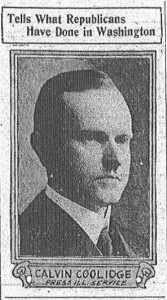
The following year, on 27 October 1922, Vice-President Calvin Coolidge was the guest speaker at a Republican rally held at the Arcadia Hall. Vice-President Coolidge declared, in front of 4,000 people, that there was no longer unemployment in the country, thanks to the Republican Party.
Then, on 1 November 1923, Assistant Secretary of the Navy Theodore Roosevelt, Jr., spoke to near 5,000 at Arcadia Hall to a collected meeting of “Stuyvesant and uptown” Republicans. In his speech he warned against having their children “Tammany-tied” in the upcoming election.
At the end of his speech the Thirteenth Regiment Band “struck up an air,” and Roosevelt was soon “being carried around on the shoulders of enthusiastic admirers.”
The Arcadia was torn down along with the Halsey Theatre and the Broadway Arena to make way for a high rise New York City Housing Authority senior housing complex, a parking lot, a small enclosed park, and a Duane Reade.
———————————————————————————————————————–
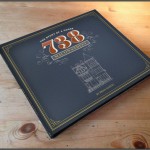 The story you have just read was composed from extensive historical research conducted by The Brownstone Detectives. We perform in-depth investigations on the historic homes of our clients, and produce for them their very own House History Books. Our hardbound books contain an illustrated and colorful narrative timeline that will bring the history of any house to life. Contact us today to begin discovering the history of your home.
The story you have just read was composed from extensive historical research conducted by The Brownstone Detectives. We perform in-depth investigations on the historic homes of our clients, and produce for them their very own House History Books. Our hardbound books contain an illustrated and colorful narrative timeline that will bring the history of any house to life. Contact us today to begin discovering the history of your home.